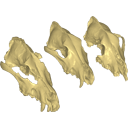















| Plane | Position | Flip |
| Show planes | Show edges |
0.0
M3#21
3D surface model of the cranium of the Late Pleistocene Canis lupus "Goyet 2860" from the Royal Belgian Institute of Natural Sciences.
Data citation:
Allowen Evin , Emmanuel Gilissen and Mietje Germonpré
, 2015. M3#21. doi: 10.18563/m3.sf21
Model solid/transparent

|
3D cranium models of fossils of large canids (Canis lupus) from Goyet, Trou des Nutons and Trou Balleux, BelgiumAllowen Evin, Emmanuel Gilissen and Mietje GermonpréPublished online: 06/11/2015Keywords: Archaeozoology; Dog; Domestication; Pleistocene; Wolf https://doi.org/10.18563/m3.1.3.e2 Abstract Archaeozoological studies are increasingly using new methods and approaches to explore questions about domestication. Here, we provide 3D models of three archaeological Canis lupus skulls from Belgium originating from the sites of Goyet (31,680±250BP; 31,890+240/-220BP), Trou des Nutons (21,810±90BP) and Trou Balleux (postglacial). Since their identification as either wolves or early dogs is still debated, we present these models as additional tools for further investigating their evolutionary history and the history of dog domestication. M3 article infos Published in Volume 01, Issue 03 (2015) |
|